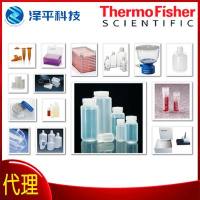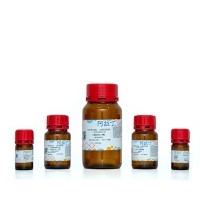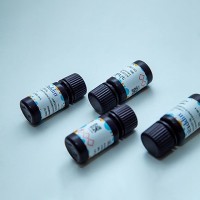|
Purpose: After spotting cDNAs onto glass slides, the slides must be treated to bind the DNAs to the coating and to denature the DNAs so they can hybridize to the fluorescently labeled probe DNA. During the blocking step the array will disappear so be sure that the boundary of the array has been marked with a diamond pin as described in microarray construction. During the process, the exposed amine (NH3 + ) groups are blocked by covalently linking them to succinic anhydride.
Reference: The basic protocol is derived from Brown lab home page as shown in http://cmgm.stanford.edu/pbrown/protocols/3_post_process.html
Record print ID and slide ID numbers: _____________________________
Person name and date: _____________________________
Check off each step as it is completed:
_____ The slides should have previously been Hydrated and UV crosslinked just after printing. Check the log and IDs of the printed slides to be sure that this was done.
_____ During the blocking step the array will disappear so be sure that the boundary of the array has been marked with a diamond pin as described in microarray construction.
_____ Prepare the following reagents and supplies: We use Wheaton #900200 glass staining dishes to do the blocking of the slides. These hold 10 slides each but we only put 6 slides in order to get the maximum blocking. Also need a small magnetic stirring bar (1/2 x 5/16 inch) and a regular stirring plate.
The following amounts of reagents are for blocking 6 slides in one glass staining dish at a time. Have all ready.
1 Wheaton slide staining dish with 250 ml of 0.2% SDS
2 Wheaton slide staining dishes with 250 ml of sterile, nanopure water
60 ml syringe with large needle (18-G-1 1/2) Lid to staining dish 250 ml gradulated cylinder (EtOH rinsed)
400 ml beaker with stir bar (EtOH rinsed)
250 ml 0.2% SDS (make using 17 ml 3% SDS + 233 ml sterile water) 1M boric acid (6.183g/100 ml H20. pH to 8.0 with about 10 pellets NaOH) 1L water in a 2 liter plastic beaker that can be boiled in a microwave
800 ml 95% EtOH in a 2 liter beaker
10 ml pipette
orbital shaker
stir plate
____1. Rinse all glassware with EtOH and dry well.
____2. Set up everything in fume hood. Place amine slides (poly-lysine or silanated) that have been spotted in glass staining rack, be sure that the position of the array has been marked as the spots in the array will disappear during blocking. (use maximum of 6 slides per rack). Place stir bar in staining dish (if an orbital shaker is not available). Place rack of spotted slides in dish Put on stir plate and verify stir bar will not hit the slides.
____3. Weigh out succinic anhydride (Aldrich #23,969-0, Lot # _________) stored under desiccation) 3.5 g for 200 mls. Keep in desiccator. Bring to hood.
____4. Plunge the slides rapidly up and down in 0.2% SDS for 2 minutes.
____5. Transfer to water to rinse. Shake 2 minutes. Repeat. After starting the second rinse, leave on
shaker while doing steps 6-8.
____6. Use syringe to remove 190 mls 1-methyl-2-pyrolidinone (Aldrich 32,863-4, Lot # ________) from sealed bottle into 400 ml beaker under fume hood . Start stirring.
____7. Add the 3.5g succinic anhydride to the 1-methyl-2-pyrolidione. Stir on stir plate to dissolve (1-3 minutes).
____8. Add 10 mls 1M boric acid to the stirring solution once succinic anhydride dissolves. (note: the solution may cloud after adding the boric acid-Brown lab says 'ok').
____9. Lift slide rack out of dish, pour in the blocking solution and quickly add slides. (Note: Slides should be lowered into solution quickly to reduce chance of smearing. Thought is that lowering slowly means DNA is starting to hydrate and slime up-hits unblocked region of slide and sticks causing smear. If add quickly, DNA doesn't hydrate rapidly enough to smear. SDS pretreatment should eliminate this problem.)
____10. Dunk rack up/down several times.
____11. Cover. Stir for 15-20 min or place on an orbital shaker. Start boiling 1L water in 2L plastic beaker in microwave.
Denaturing DNA:
____12. While slides are in the succinic anhydride solution, prepare - boiling water (microwave one liter in a plastic beaker for 8-10 minutes) - 2L beaker with about 800 mls of 95% EtOH (enough to cover rack of slides)
____13. After 15-20 min in blocking solution, plunge the slide rack into hot water (95-100c) for 2 minutes going up and down 4-5 times to remove blocking solution. Discard the 1-methyl-2-pyrolidinone solution into the waste container in the hood.
____14. Transfer rack of slides to 95% EtOH. Plunge up and down several times.
____15. Quickly transfer the slides from the Wheaton glass slide holder to a metal slide rack. Place rack of slides on top of styrofoam pad (prevents metal rack from bending down in the middle). Spin for 2 min at 500 rpm to dry.
____16. Slides are ready to hybridize or may be stored at room temp in slide box.
Original Protocol from Pat Brown Lab (http://cmgm.stanford.edu/pbrown/protocols/3_post_process.html)
-
Mark boundaries of array on back of slide using diamond scriber. Array will become invisible after post-processing.
-
Fill bottom of humid chamber with 100 ml 1X SSC.
-
Prop slide between two tip boxes with lamp overhead and etch corners of array.
-
Place arrays face down over 1X SSC and cover chamber with lid.
-
Rehydrate until array spots glisten, approximately 5-15 minutes. Allow spots to swell slightly but not run into each other. Position a lamp ~ 12" overhead.
-
Snap-dry each array (DNA side up) on a 70-80C inverted heat block for 3 seconds.
-
UV crosslink DNA to glass with Stratalinker set for 65 mJ. (Set display to "650", which is 650 x 100 uJ.)
-
Place arrays in slide rack. Have empty slide chamber ready on orbital shaker. Be sure the rack is bent slightly inwards in the middle, or else the slides may run into each other while shaking.
-
Prepare BLOCKING SOLUTION:
-
Have three 350 ml glass chambers available (with metal tops) and a large round pyrex dish with dH2O ready in the microwave. At this time, prepare the 15ml sodium borate in a 50 ml conical tube.
-
Dissolve 6 g succinic anhydride in approx. 325-350 mL 1-methyl-2-pyrrolidinone. Rapid addition of reagent is crucial.
-
Immediately after the last flake of the succinic anhydride dissolves, add the 15 mL sodium borate (1M).
-
Immediately after sodium borate solution mixes in, pour solution into empty slide chamber.
-
Plunge slide rack rapidly and evenly in solution. Vigorously shake up and down for a few seconds, making sure slides never leave solution.
-
Mix on orbital shaker 15-20 min. Meanwhile, heat water in pyrex dish (enough to cover slide rack) to boiling.
-
Gently plunge slide rack in 95C water (just stopped boiling) for 2 min.
-
Plunge slide rack 5X in 95% ethanol.
-
Centrifuge slides and rack for 5 min. @ 500 rpm. Load slides quickly and evenly onto the carriers to avoid streaking.
-
Use arrays immediately or store in slide box.
|







